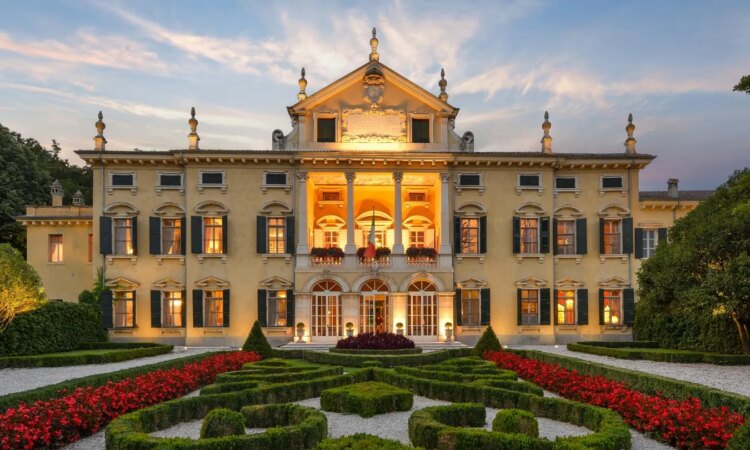
Villa Sigurtà
Tuscany Now & More
Just beyond the rolling hills of Valeggio sul Mincio—where Lombardy and Veneto meet across Italy’s Mincio River—Villa Sigurtà rises like a majestic Italian palace. Once the summer playground of counts, kings, and luminaries, this fully staffed estate now opens its gates to modern nobility, welcoming guests with gourmet chefs, personal butlers, frescoed salons, a Technogym-equipped gym, three secluded guesthouses, and eight palatial bedrooms once graced by Maria Callas and King Constantine of the Hellenes. Offered exclusively through Tuscany Now & More—the villa specialist renowned for unlocking Italy’s most aristocratic addresses—it is a time capsule of baroque elegance. Nestled within the legendary Sigurtà Gardens—where Vivaldi composed and Fleming once stayed—and with Lake Garda’s lemon groves and Verona’s opera nights just minutes away, this isn’t merely a stay. It’s a sovereign experience.
The villa’s story begins in 1649, when the Counts Maffei—one of northern Italy’s most powerful families—commissioned a summer residence designed by Vincenzo Pellesina, a Veronese architect inspired by Palladio. A century and a half later, amid the Risorgimento—the movement for Italian unification—Villa Sigurtà assumed a strategic role. In 1848, the villa served as a command post for Emperor Franz Josef I and Field Marshal Radetzky as they orchestrated the Campaign of Italy; in 1859, Napoleon III claimed it as his residence. Why? Its location—poised between Verona, Mantua, and Lake Garda—made it a natural staging ground for statesmen navigating Italy’s fractured alliances.
Read More:
Today, guests are welcomed by Count Jose Antonio Sigurtà himself, who often returns from Madrid to greet visitors personally. His recollections are vivid: Sir Alexander Fleming, a close friend of his grandfather, once stayed here; King Charles III (then Prince of Wales) visited to admire its rare blue lilies. The villa’s modern chapter began in the mid-20th century, when the Sigurtà family acquired and restored its neoclassical interiors and gardens. Under their stewardship, Villa Sigurtà became a magnet for royalty, artists, and intellectuals—including Queen Victoria Eugenia of Spain, Prince Pierre of Monaco, and Nobel Prize–winning scientists.
The Room of the Treaty at Villa Sigurtà.
Tuscany Now & More
As you meet its towering gates and stroll past a manicured Italian garden, you’ll come face to face with the villa’s glowing sandstone façade—frescoed, symmetrical, and serenely Palladian. Step into a stately marble reception hall that spills into The Ambassador’s Saloon, once the gathering place for diplomats brokering the Treaty of Villafranca—a pivotal 1859 accord that ended the Second Italian War of Independence. Here, lime velvet sofas rest on terrazzo floors, warmed by brass-gilded sconces—as your personal staff of nine awaits: a butler, waitress, chef, gardener, house manager, and three housekeepers—welcoming you with chilled flutes of Venetian Brut and Bardolino sparkling rosé.
Read More:
Beyond The Ambassador’s Saloon, a quartet of sitting rooms unfurls like chapters in a living memoir. In the Imperial Office—once the Emperor of Austria’s private study—pause beside an oil portrait of the Emperor and browse photographs of royals who slept beneath this roof. Or, play a hand of bridge in the French Room, wrapped in apple silk and warmed by one of the villa’s rare fireplaces—just as the Count’s grandmother did beneath the gaze of a grand portrait of the Sun King, Louis XIV. Meanwhile, across the Saloon, admire the wall-mounted collection of Philippine court fans in the Fans Room, or take afternoon tea in the lemon-bathed Tea Room.
Ambassador’s Saloon at Villa Sigurtà.
Tuscany Now & More
Ascending the grand staircase beneath a soaring fresco of the Fall of Phaeton, you’ll reach the noble loggia, gazing out over the formal Italian garden and rooftops of Valeggio. Reenter the villa through the Room of the Treaty, where the 1859 accord was negotiated. Here, giant coral sculptures, gilded sofas, and a three-tier chandelier set the stage for competitive board games paired with sharp Negronis—served from the antique trolley gleaming with crystal decanters.
Read More:
Down a corridor lined with stag antlers and towering taxidermy, you’ll discover Villa Sigurtà’s flagship suite—the Emperor’s Room. Slip into your silk-draped crown-canopied bed or unwind with a soak in your 1920s-style bathroom—complete with a mosaic-wrapped tub, pink toilet paper (had to be mentioned), and a seashell cupboard that doubles as a secret door to a walk-in wardrobe. Meanwhile, the lounge offers a quiet retreat with comfy sofas, a giant film set spotlight, and an oil portrait of Italy’s first king—plus a polyptych created by Count Sigurtà himself.
The Emperor’s Room at Villa Sigurtà.
Tuscany Now & More
On the far side of the Room of the Treaty, you’ll find a warren of intimate salons. Watch a classic opera in the House Theatre—where Vivaldi once composed La Fida Ninfa—behind velvet curtains and a grand oil portrait of the Count’s grandmother. Or dine by candlelight in the Room of Neptune, surrounded by floating jellyfish chandeliers and gilded mirrors.
Then, retreat to the Countess’ Room for digestifs under a Murano glass chandelier—and pick up a book in the snug Billiard Room, where a vast, floor-to-ceiling library meets a monumental snooker table. Just beyond, six bedrooms await—some boasting sculptural flourishes by Tony Duquette—including the Maria Callas Room, a tribute to the legendary soprano who stayed here and adored its quiet grandeur.
Billiard Room at Villa Sigurtà
Tuscany Now & More
Mornings begin in the chef’s kitchen, where platters of apple cake, maple-pecan pastries, and croissants oozing with cheese and ham beckon beside freshly squeezed juices and honey dripping lazily from the hive. Eggs are cooked to order; cappuccinos are hand-swirled to marble perfection, then carried next door to the Hunting Room.
Beneath a Murano chandelier, settle among 17th-century murals of galloping hounds and pheasants, flanked by photographs of the family’s beloved dogs—including Lady Baltimore, the family poodle, currently gallivanting through Spain. In summer, breakfast moves to the rear terrace, overlooking the private gardens—once the ceremonial stage where soldiers paid tribute to the Emperor of Austria.
Breakfast at Villa Sigurtà.
Tuscany Now & More
From here, the day unfolds across Villa Sigurtà’s three-hectare grounds—among Italy’s most important historic gardens. Stroll through the nation’s first pre-romantic English garden, where century-old trees cast dappled shadows across winding paths. One of the most remarkable is the 400-year-old Ginkgo Biloba, among Italy’s largest and one of the first to be brought to Europe from Japan. Nearby, the 300-year-old giant Buxus Gardens were described by Queen Victoria Eugénie of Spain as “reminiscent of a family of elephants.” At the heart of the gardens, a 60-meter stream symbolizes the nearby Mincio River.
Read More:
Bringing children? A winding path leads to the Maffei Nymphaeum—an enchanting amphitheater where Vivaldi and Scipione Maffei once drew inspiration for La Fida Ninfa. Here, little ones can while away summer hours in the estate’s private swimming pool, shimmering beside ornate fountains and cascading waterfalls—overlooked by a row of cushioned loungers and parasols.
Maffei Nymphaeum at Villa Sigurtà.
Tuscany Now & More
Meanwhile, tucked discreetly beyond the main villa, three contemporary guesthouses are scattered across the estate. Villa Leandra and Villa Carla share a heated plunge pool perfect for late-morning dips or moonlit soaks. A short stroll away, Villa Clelia, once a gentleman’s golfing retreat, is romantically ensconced in the gardens—with its own secluded plunge pool and a view that feels lifted from a Renaissance painting. Its guestbook reads like a royal almanac: Fleming stayed here, as did Queen Victoria Eugénie.
Next door, Park Sigurtà—once part of the estate—unfurl in spectacular fashion. Voted “Italy’s Most Beautiful Park,” they dazzle each spring with over one million tulips in bloom.
Throughout the day, the villa’s concierge curates experiences tailored to your rhythm: morning yoga or personal training in the open air, live cooking classes to master Tortellini di Valeggio—The Love Knot—or curated wine tastings sampling Veneto gems like Valpolicella Superiore Casa Vecie 2023 or Roccolo del Durlo Soave Classico 2021.
Craving a deeper taste of local life? Step beyond the villa into Valeggio sul Mincio’s historic heart—where family-run trattorias like Alla Borsa serve handmade tortellini di Valeggio. Just a five-minute stroll away, artisan bakeries perfume the air with fresh focaccia, and riverside wine bars invite locals to linger over aperitivo as the Mincio glides past. A little further, Borghetto sul Mincio beckons with its ancient watermills-turned-restaurants, cobbled lanes, and romantic ruins of Castello Scaligero.
Borghetto near Valeggio sul Mincio.
getty
Further afield? Discover the fairytale hamlet of Castellaro Lagusello—a fortified medieval village nestled in the Morainic hills near Monzambano. From there, spend the afternoon at Lake Garda—Italy’s largest—where the southern shores invite you to stroll sun-drenched promenades, savor gelato in Desenzano, and drift through golden hour on boat rides past lemon groves and pastel villas. In Sirmione, the mineral-rich waters of Terme di Catullo steam beside the ruins of a Roman villa. Inland, however, Mantua enchants with Mantegna’s frescoed Camera degli Sposi—trompe-l’œil illusions conjuring courtly life beneath vaulted ceilings.
And in Verona? Think opera beneath the stars in its ancient Roman Arena, while the city invites you to wander Juliet’s balcony, sip Amarone in hushed wine bars, and trace centuries of history through Roman gates, medieval towers, and Renaissance piazzas.
Back at the villa, as evening settles, aperitivo hour begins—a daily ritual hosted by the butler, who serves Negronis, chilled champagne, and delicate nibbles: think slender olive skewers, Parmesan crisps, and bite-sized tartlets.
Later, guests return to the Hunting Room for a candlelit four-course affair beneath gilded candelabra. Imagine a cloud-like cheese soufflé, heirloom tomato risotto, charred Sicilian aubergine, hand-folded pumpkin tortellini, or a seared steak—blushing at the center. Meanwhile, the staff quietly pours Conti Sigurtà—a rare, estate-only label drawn from the family’s 16th-century vineyards. Overseen by their in-house enologist, these small-batch wines, including a velvety Amarone and graceful Custoza Superiore, are never sold on the open market—shared only by whispered recommendation. And for dessert? Graze on silken tiramisu, vanilla panna cotta, or a torched crème brûlée with its signature glassy crust.
The Hunting Room at Villa Sigurtà.
Tuscany Now & More
And then, the hush. The villa quiets. The frescoes dim. The final glass is poured. And beneath the gaze of emperors, kings, and ancestral ghosts, you slip into slumber—wrapped in silk, steeped in centuries-old history.
How To Do It
Rates at Villa Sigurtà begin at $39,552 per week for the fully staffed, ten-bedroom estate. Stays are offered exclusively on a weekly basis, with a minimum stay of one week. To book, visit tuscanynowandmore.com.





